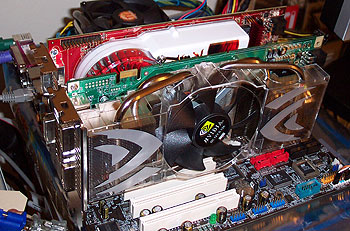Thoughts
NVIDIA's efforts with the new G70 earn them the overall performance crown back, and by quite some margin. At 550MHz across the board and with 512MiB of memory running at 1.7GHz effective, it would have been embarassing had that not been the case. That didn't happen, though, and the reference-clocked GTX 512 has no trouble dispatching GeForce 7800 GTX and Radeon X1800 XT to the sidelines.Quite simply a performance monster, and one that'll take ATI a big effort to beat. The GeForce 7800 GTX 512 impresses hugely, from quiet and efficient cooler, to manageable increase in power draw over the original GTX, with monsterous performance and day-zero availability in-between.
While certain facets of ATI's new Radeon hardware make it more appealing on paper, it's taking time for those technological advantages to come to fruition as part of games, making the latest GeForce hardware even more appealing in the interim. The current real-world performance of both GTX and GTX 512 cement that statement.
I'd have liked to have seen the second DVI port be dual-link, too, but that's about all I'd change on the physical side of things. Dual-slot makes no difference in the face of the competition, especially when the cooler does so well.
There's plenty that I haven't shown explicitly in graphs, which are also real upsides to the GTX 512 hardware, versus the original GTX that now sits below it. Transparency antialiasing is usable more of the time, and 8xS becomes a mode worth trying out more often than not (even at high resolution). Disabling the default filtering optimisations across the board almost becomes an academic thing to do, too, given the surplus of texture sampling rate available on the 550MHz GPU. We simply didn't have the time to check out 8xS performance in more detail, sadly.
Future testing to examine same-clock performance versus the 256MiB GTX will have to wait, too. Hopefully the performance investigation at high resolutions is enough to satisfy for the time being. In short, the GeForce 7800 GTX 512 has instantly become the fastest single consumer graphics board money can buy. Only NVIDIA's own 7800-based SLI solutions can go faster at the time of writing. The performance is carried well, too, with a great cooler and good usable features.
At a launch price of £516.99 including VAT right now, from Scan, you can have one in your hands today if you're feeling flush. It's a fair chunk more expensive than the current ~£410 required to secure a Radeon X1800 XT, but then the performance difference will often make the higher price seem good value.
Look out for SLI testing with another GTX 512 at HEXUS, versus 7800 GTX SLI, in the very near future. The following combination doesn't quite work yet, heh.
HEXUS Awards

















